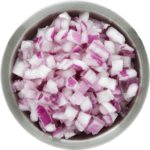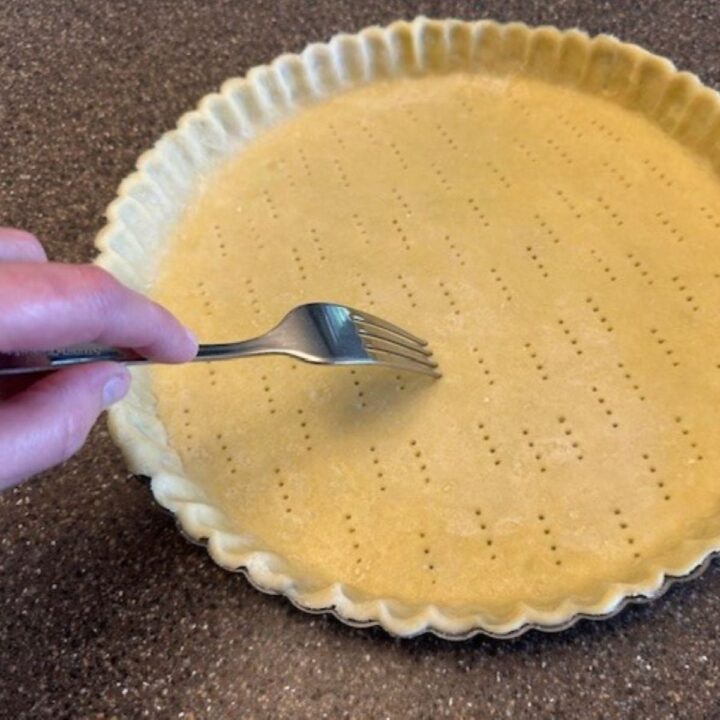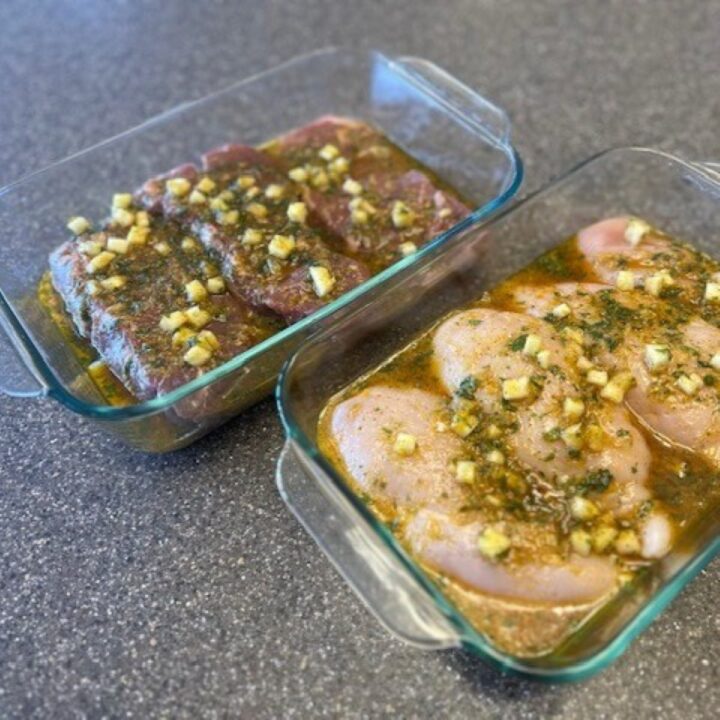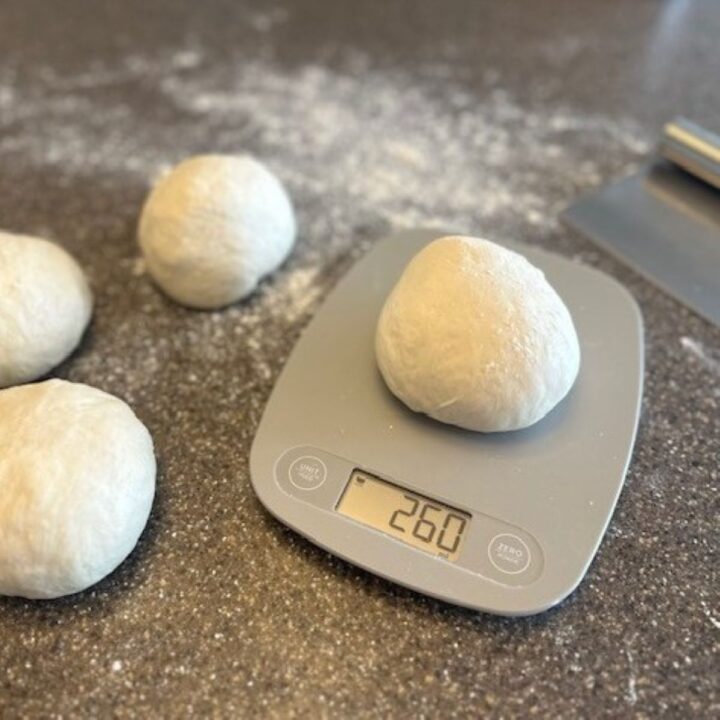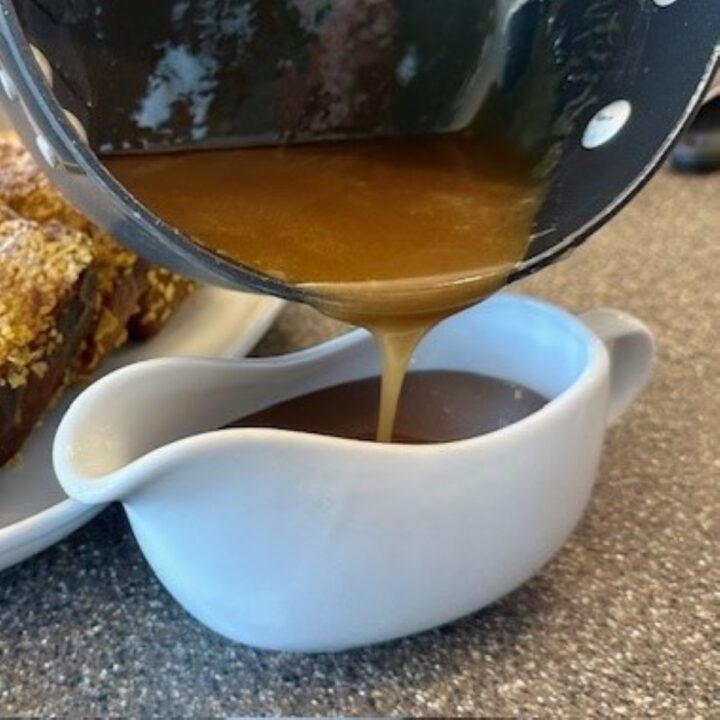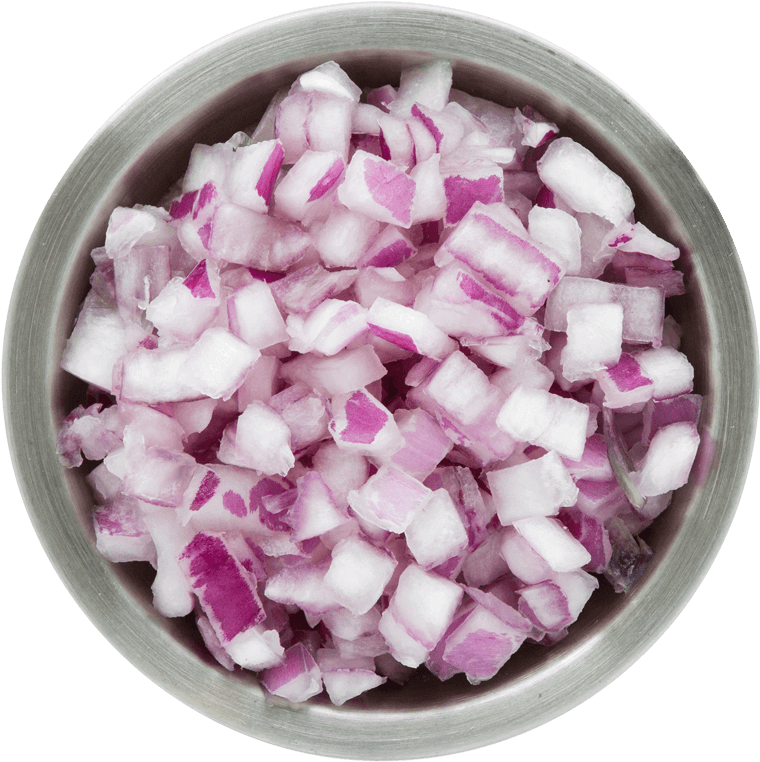
Start by ensuring that you have a sharp chef's knife ready before you begin. This is critical to ensure that as you are slicing through the onions' layers, you are minimizing the release of the enzymes that cause irritation to the eyes, and therefore, avoiding tears.
A simple sharpening knife steel, such as this one from Amazon is much more economical than replacing your knives when they go dull. With a little practice, using a steel to sharpen your knives is easy to do, and will become like second nature. In culinary school, they taught us to hold the steel in our non-dominant hand, and the knife in the other. Bending at the wrist, start by dragging the knife at an angle from the base to the tip on one side, and then repeat on the backside of the steel, sharpening the opposite side of the knife. Continue back and forth for several turns, as though you were playing a violin.
Be sure to rinse your knife thoroughly after cleaning, to ensure there are no remaining shards of steel.






Next, you'll want to grab a damp paper towel, place it on your work surface, and lay your plastic cutting board on top. The paper towel will help hold your cutting board in place and stabilize the motion of your cutting, so that it doesn't move. This also helps to prevent accidents that It is important not to use a wooden cutting board when working with onions, as the wood will absorb the natural enzymes in the onion (the same ones that make you cry!) and are near impossible to remove the smell.
Take a look at your onion. Regardless of the type of onion you are holding (red, yellow, white, or Spanish...even a shallot), you'll find the root end of the bulb on one end, and the stem at the other. This is important to recognize which is which, as it makes a difference as to how you begin cutting your onion.
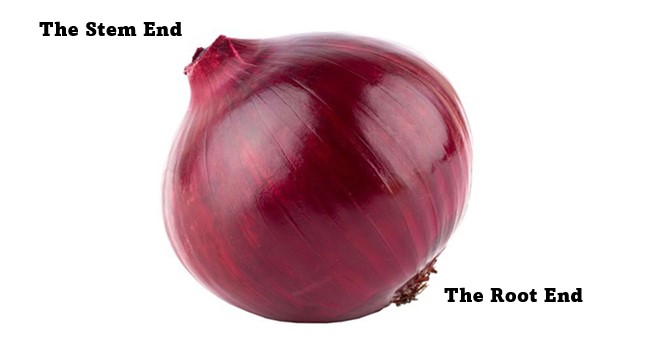
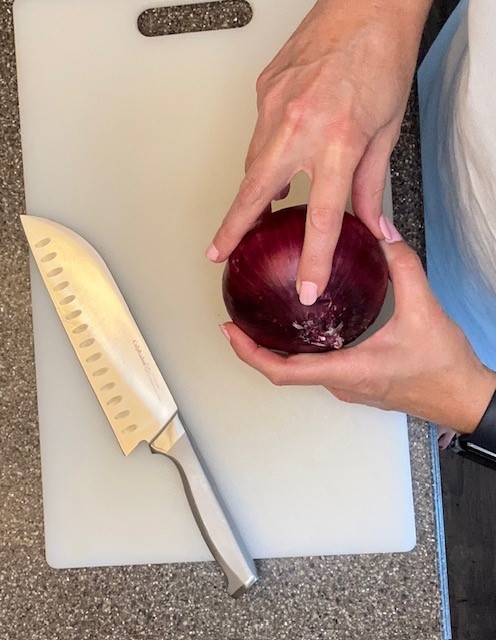
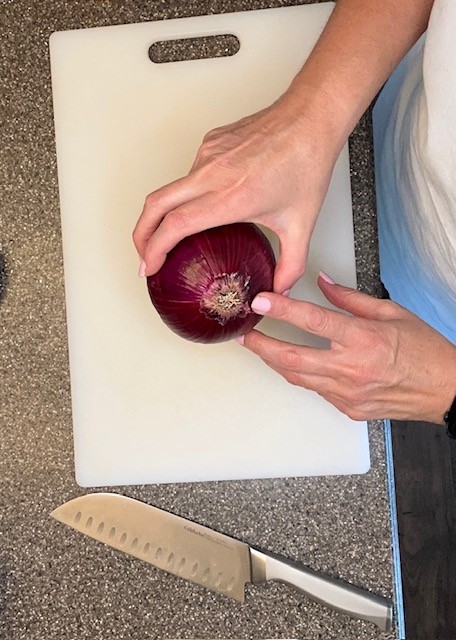
Carefully holding the onion in place, start by slicing off the bottom portion that severs the 'stem' end, just enough to give you a flat surface from which to work from moving forward.
Next, lay the flat end down on the cutting board so that the root end is now facing directly upwards. Using your knife, slice down through the center of the onion vertically. You now have two equal halves with a portion of the root end intact.
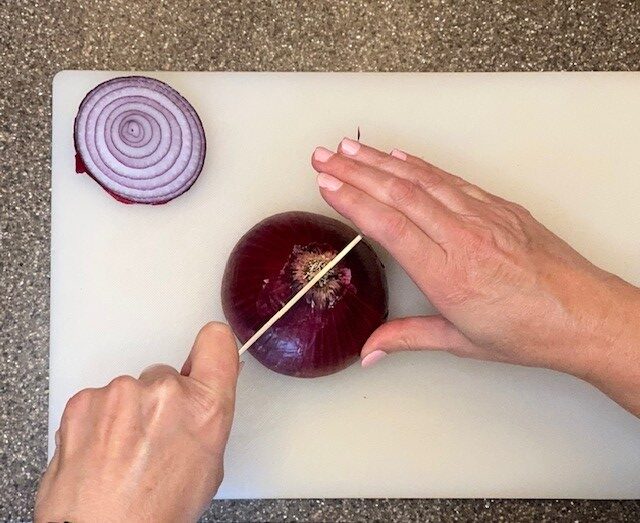
Peel away the thinnest, paper layers of onion skin away. The remaining top layer should be shiny.
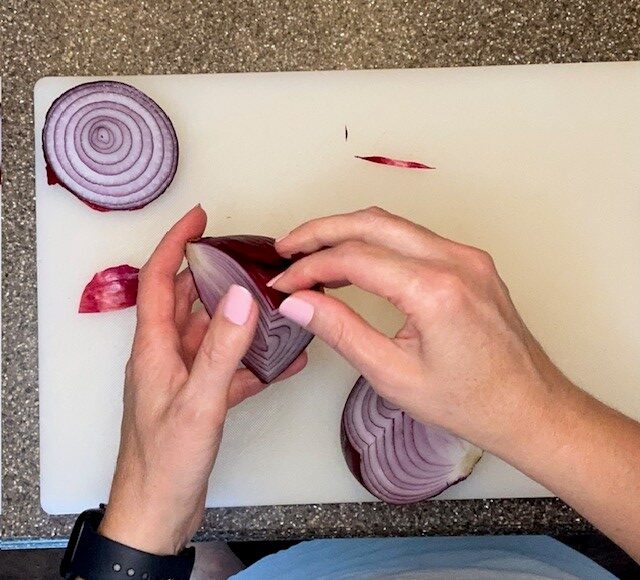
Lay the flat side of one half of the onion against the cutting board, with the root end closest to you. Press the palm of your non-dominant hand on top of the onion, with fingers extended. Holding the knife towards you, carefully saw two to three cuts towards the root end, slicing the onion horizontally, but only cutting ⅔ of the way through.
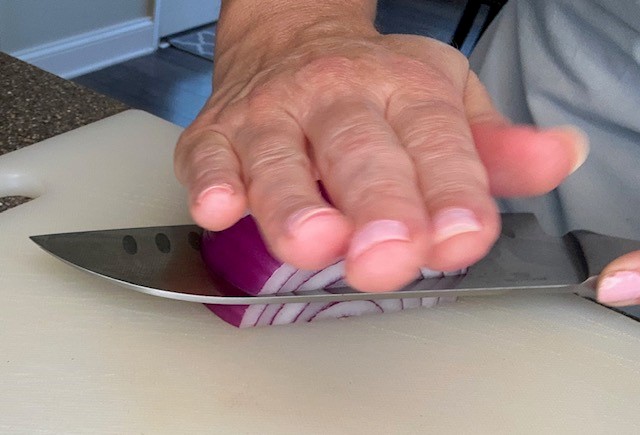
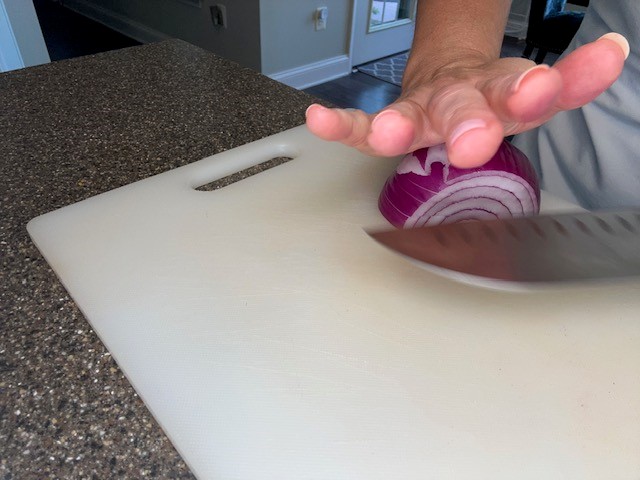
Rotate the onion so that the root end is away from you, facing the center of your palm, and the sliced side is facing you. Place your thumb on one side and your forefingers on the opposite side of the onion and hold firmly. Using your knife, slice lines straight down through towards the cutting board, starting in the center and working your way out towards both sides.
The larger the space between the lines, the larger the dice. If you slice cuts closer together, you'll have a finer dice.

Rotate the onion once again. With the root end closest to you, and the cut end facing away, curl the fingers of your non-dominant hand over the root end, and tuck your nails under so that they are lying flat against the top of the onion. The surface between your mid and lower knuckles will provide a smooth surface to which you can guide the blade of the knife, without fear of cutting your fingers.
Starting at the cut end, begin making smooth and consistent cuts, rocking the knife blade back and forth in one swipe across the onion, and repeat. You want to lead with the tip of the knife and press down and away as the knife makes its' way through. You want to avoid any type of sawing motion- let your wrist do all the work. Continue until you have gotten as close to the root end as you have made your cuts lengthwise.
That little cushion of space by not cutting all the way through will protect you and your fingers!
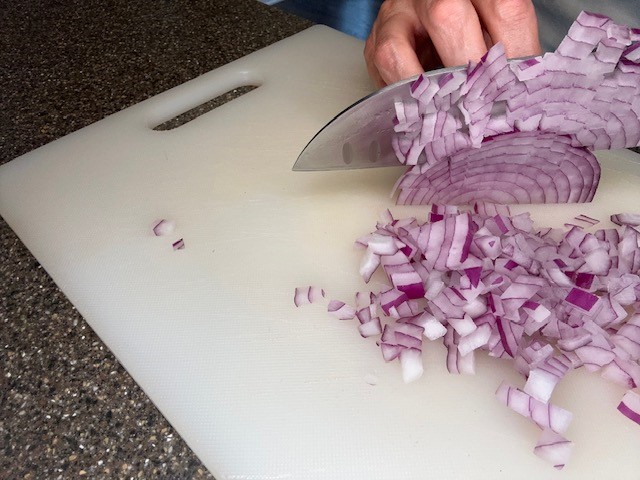
Dicing an Onion
Equipment
- Plastic Cutting Board preferably PBA free, and definitely not made of wood
- Damp Paper Towel
- A Sharp Chef's Knife
Materials
- Onion
Instructions
- Before getting started, make sure you have a sharpened chef's knife. Dull knives will struggle to cut through the onions' layers and will undoubtedly bring tears to your eyes, causing irritation and making it difficult to see.
- Place a damp paper towel on your work surface and lay your cutting board on top. This will keep your cutting board stable, as well as helping to prevent injuries.
- Take a look at your onion. Regardless of the type of onion you are holding, red, yellow, white, or Spanish (even shallot), on one end, you'll find the root end of the bulb, and at the other the stem. This is important to recognize which is which, as it makes a difference as to how you begin cutting your onion.
- Carefully holding the onion in place, start by slicing off the bottom portion that severs the 'stem' end, just enough to give you a flat surface from which to work from moving forward.
- Next, lay the flat end down on the cutting board so that the root end is now facing directly upwards. Using your knife, slice down through the center of the onion vertically. You now have two equal halves with a portion of the root end intact.
- Peel away the thinnest, paper layers of onion skin away. The remaining top layer should be shiny.
- Lay the flat side of one half of the onion against the cutting board, with the root end closest to you. Press the palm of your non-dominant hand on top of the onion, with fingers extended. Holding the knife towards you, carefully saw two to three cuts towards the root end, slicing the onion horizontally, but only cutting ⅔ of the way through.
- Rotate the onion so that the root end is away from you, facing the center of your palm, and the sliced side is facing you. Place your thumb on one side and your forefingers on the opposite side of the onion and hold firmly. Using your knife, slice lines straight down through towards the cutting board, starting in the center and working your way out towards both sides. The larger the space between the lines, the larger the dice. If you slice cuts closer together, you'll have a finer dice.
- Rotate the onion once again. With the root end closest to you, and the cut end facing away, curl the fingers of your non-dominant hand over the root end, and tuck your nails under. The surface between your knuckles will provide a smooth surface to which you can guide the blade of the knife, without fear of cutting your fingers.
- Starting at the cut end, begin smooth and even cuts (avoid using a sawing motion), rocking the knife blade back and forth in one swipe across the onion, and repeat. Continue until you have gotten as close to the root end as you have made your cuts lengthwise.Voila... perfectly diced onion!

